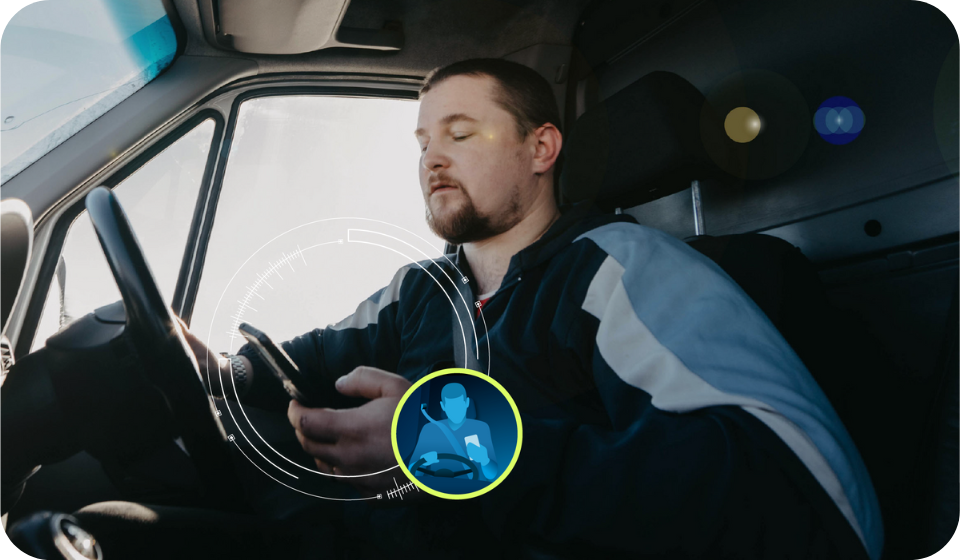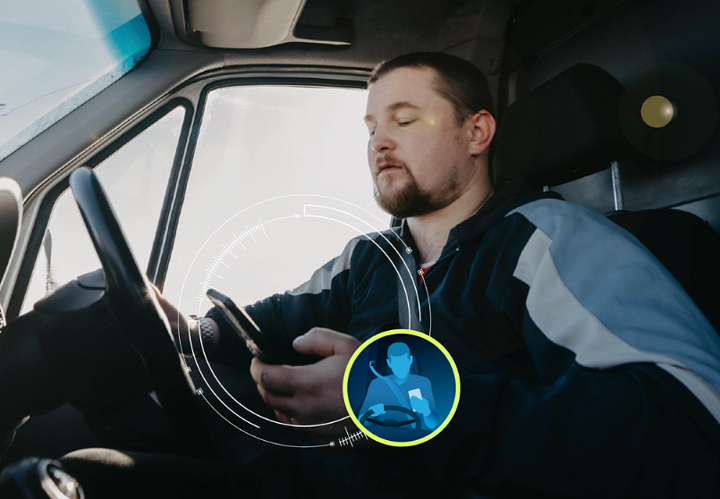The transport sector’s adoption of AI distraction cameras has sparked a considerable debate, touching on issues from privacy and data security to operational efficiency and driver accountability.
So as both Unions and drivers express their concerns, it’s important to fully understand the technology, including key concerns, best practice approach and collaboration opportunities.
Understanding driver concerns
AI-powered cameras are designed to monitor driving behaviour, enhance safety, and optimise transport operations; however, a number of concerns have been raised along the way by drivers and their representatives.
In this blog post, we discuss the four most common driver concerns, offering solutions to each – alongside best practices – and highlighting the benefits of Union collaboration.

Driver concern #1 - Mental wellbeing
AI-powered dash-cams monitor driver behaviour to ensure safety, but their constant presence could make drivers feel watched and scrutinised, leading to stress and anxiety. This sense of surveillance can erode trust and job satisfaction, leaving drivers feeling undervalued and pressured to avoid mistakes.
The solution
To mitigate this, it’s important to communicate the primary goal of the technology: enhancing safety, not surveillance. Implement systems that only alert to risky driving behaviours and ensure strict permissions around footage access, preferably providing an audit trail showing who accessed the footage. Look at technology that only records when an event is triggered and does not use facial recognition or any other technology to distinguish between one driver and another. Providing GDPR trained and transparent policies on data can help build trust.
Driver concern #2 - Trust and use
Drivers may worry that AI-camera footage will be used to punish rather than support and train them. This fear can lead to mistrust, as drivers feel the technology will only highlight their faults, potentially resulting in penalties and a negative work environment.
The solution
To build trust and ensure transparency, transport operators should actively include their drivers in footage review sessions. Highlighting and celebrating positive examples to demonstrate good driving behaviour and the benefits of this type of technology is encouraged, especially examples of drivers having been exonerated.
Driver concern #3 - Data privacy
Privacy is one of the biggest concerns drivers have with AI distraction cameras, particularly regarding what is being recorded, how long the footage is stored for and who has access to it. The fear of misuse or unauthorised access to personal data can lead to anxiety and resistance to the technology.
The solution
Privacy concerns can be addressed by ensuring compliance with local data protection laws, such as GDPR. Adopt transparent policies that clearly outline what is recorded, data retention schedules and access controls, and implement robust data security measures to prevent unauthorised access. Communicate these measures clearly to drivers, reinforcing the message that their privacy is a top priority.
Driver concern #4 - Technology overload
Drivers today are surrounded by technology, from GPS and ePOD to safety monitoring systems, which can be overwhelming. The addition of AI distraction cameras may be seen as yet another layer of complexity, potentially causing further distraction and adding to the reluctance to adopt new solutions.
The solution
To ease technology overload, transport operators should implement solutions that integrate seamlessly, reducing the need for drivers to interact with multiple systems. Provide comprehensive training to ensure drivers understand how each piece of technology works and its purpose, eliminating any perceived redundancies.
Prioritise user-friendly interfaces and streamlined processes to minimise the technological burden on drivers, making their jobs easier and more efficient.
Best practice approach
Addressing driver concerns around the use of AI distraction cameras requires a thoughtful and systematic approach grounded in industry best practices. To implement these technologies ethically, it’s important to make sure it benefits everybody involved, from drivers to fleet operators.
Here’s some best practice techniques to consider:
1. Communicate
Clear communication is a must. Before implementation, it’s important to speak openly to all stakeholders, including drivers and Union representatives. Explain the purpose, workings and benefits of AI cameras. Encourage questions and address any concerns to foster understanding and acceptance.
2. Protect
Develop a robust privacy policy that complies with relevant legislation, such as GDPR. Use techniques such as blurring faces and registration plates in video clips, limiting access to sensitive data to reassure employees about their privacy rights and the security of their personal information. This helps build trust and confidence in the solution.
3. Be transparent
Transparency in policymaking is also paramount. Develop clear and detailed policies outlining how data is collected, stored and used. Ensure adherence to local laws and agreements made with Unions. This openness fosters trust and demonstrates a commitment to ethical practices.
4. Encourage feedback
Creating feedback opportunities allows drivers to voice their concerns and facilitates greater information sharing. Use methods like regular meetings, suggestion boxes and anonymous surveys to create a platform for open communication and continuous improvement. This involvement helps drivers feel valued and heard.
5. Provide training
Provide thorough training and support to help drivers become comfortable and proficient with the technology. Training sessions should focus on practical use, addressing any technical issues or concerns that may arise. Continuous support ensures drivers can use the technology effectively and confidently.
6. Reward
Positive reinforcement is a powerful motivator. Use AI distraction camera data to highlight and reward good driving habits. This approach transforms the perception of AI distraction technology from an intrusive surveillance tool to a supportive aid. Emphasise the benefits, such as enhanced safety and the potential to exonerate drivers from false claims, to reinforce its value. Remember, around 75% of the time, a collision is not the driver’s fault.
Implementing these best practices ensures that AI distraction cameras are used in a way that respects drivers’ rights, enhances their working conditions and supports the overall goals of safety and efficiency in the transport industry.
By fostering an environment of trust, transparency, and continuous improvement, companies can successfully integrate this technology and maximise its benefits for all stakeholders.
Union collaboration
Working closely with driver unions is essential for the successful integration of video telematics, particularly AI distraction cameras. Unions play a critical role in shaping policies that are fair and represent drivers’ personal interests, ensuring a balanced and transparent approach.
With the core goal of the solution to promote good driving behaviours, ensuring drivers are acting in a safe and legally abiding manner, presenting current company safety statistics to showcase the scale of the challenge the company is aiming to improve, can enable a collaborative approach between parties.
Policy co-creation
One of the most effective ways to ensure the success of AI distraction cameras is through policy co-creation. By collaborating with Unions from the outset, policies can be developed that reflect the interests of drivers while maintaining transparency.
This collaborative approach builds trust and acceptance, as drivers can see their input and concerns being considered in final implementations.
Joint reviews
Regular joint reviews of the technology’s impact and associated policies are vital. These reviews should include substantial Union input to ensure that practices can be adjusted in response to feedback. This ongoing evaluation helps the technology continue to serve the both the company’s goals and the employees’ needs effectively.
Involving Unions in these reviews provides an open line of communication and quickly addresses any issues that arise, fostering a cooperative environment that benefits all stakeholders.
Together, these steps form a strategic approach that not only mitigates resistance but also enhances the efficacy and acceptance of AI distraction cameras. By respecting drivers’ rights and contributing positively to their working conditions, this helps to ensure that the technology is implemented in a way that support and protects the workforce.




